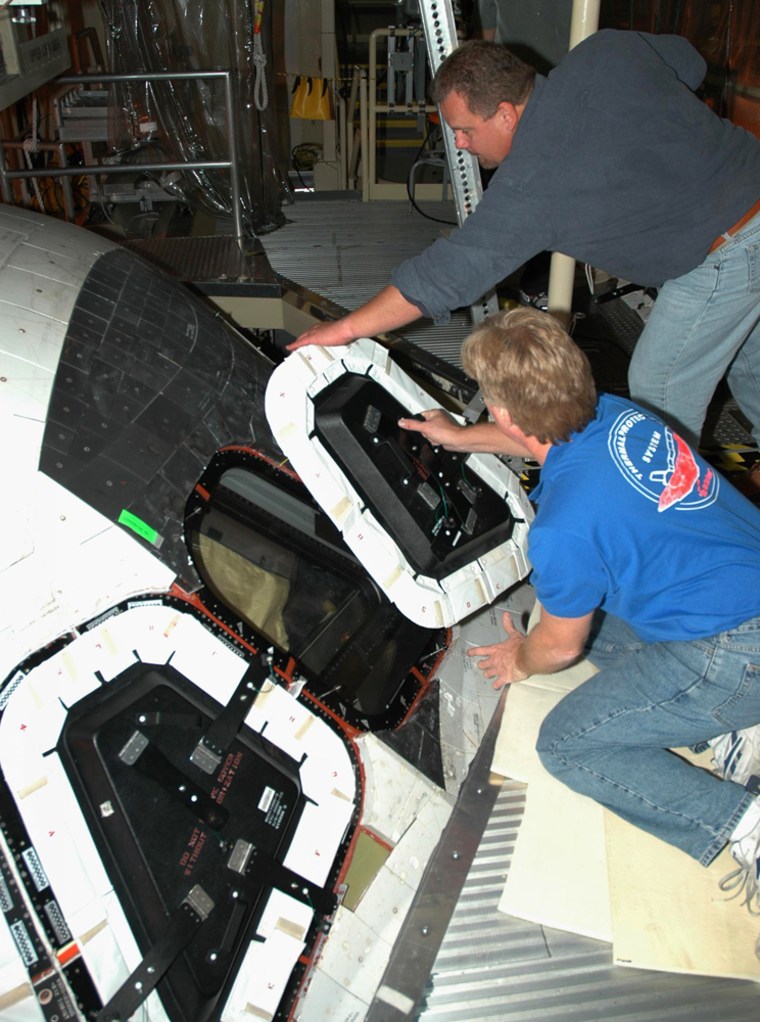Will the shuttle Discovery be ready for launch in May? Space workers tell MSNBC.com that there are a host of technical issues, or "ankle-biters," that need to be resolved first — in addition to the larger issue of clearing a redesigned external fuel tank for safety. Here are some of the "ankle-biters":
Windows: Engineers at NASA's Kennedy Space Center have recently discovered what they described as a “myriad of window issues” on the shuttle’s cabin, issues that might require that the windows be removed, repaired, reinstalled and retested. Engineers said such work would have “an impact at this point in the flow.”
The issue concerns the overhead windows at the back end of the flight deck, where “some window inserts no longer meet the self-locking requirement” (in the words of a shuttle operations contractor in Houston). Concerns have grown about the vibration and noise environment of these windows during launch. Specialists are trying to develop and verify some techniques to repair the windows in place.
Tank ‘dry’ sensor: Although the fuel tank is ready to be shipped, thanks to some last-minute foam application in areas recently realized to present ice-formation problems, a full-scale test of the tank’s sensors last weekend detected (and then verified on a second test) a variable electrical resistance in the wiring of one of the emergency cut-off sensors. NASA is sensitive to this particular malfunction because a subtle electrical problem in the same type of sensor forced a significant delay in the final countdown to last summer’s launch.
Main engine seals: When testers discovered that some pressure seals were leaking on two of Discovery’s three main rocket engines, the decision to replace the seals was complicated by the unpleasant discovery that the vendor no longer had any seals in stock with the precise specifications required for the engines. Despite efforts described as "heroic," even the two dozen closest seals "were all undersized," a representative of the engine contractor told Thursday’s meeting.
Engineers picked the best four seals, installed them in the engines and then performed rigorous leak tests. The replacement parts held. While the engines were being reinstalled at the back end of Discovery, engineers began a safety analysis to verify that the slightly-out-of-size seals were safe to fly. In the event the calculations raised doubts, a new batch of precisely sized seals will be delivered to Kennedy Space Center in mid-March.
Gap filler replacements: Discovery is undergoing fast-paced servicing of its thermal protection system, with almost 100 tiles still missing and almost 200 others requiring small repairs. The "gap filler" insulation strips that gained notoriety during the last mission are also in the final stages of being replaced, with about two weeks of work remaining. Not long ago, as the number of replacements soured and the replacement rate fell well below planned, the processing schedule had been marked "red" — not ready.
Engine contamination: During a routine inspection using a flexible boresight, workers also found a tiny metallic scraping (estimated at about 0.08 milligram) on the debris filter leading into an engine valve. During flight, the flow of liquid oxygen might cause the fragment to burst into flame, so engineers are analyzing options to remove it while determining if it might still be safe to fly leaving it in place.
Potential wing damage: Some engineers have raised concerns about one of the left-wing leading edge's high-temperature panels (the same kinds of panels that were mortally wounded by debris on Columbia). They say the panels may have experienced a minor impact during launch last year. Analysis is continuing.
The infamous "bird strike" witnessed during last year’s launch also came up again, and according to an attendee at Thursday’s meeting, "the topic turned out to be more interesting and emotional than expected." The conclusion: "We need to talk more about what to do with this risk."
Hydraulic pressure unit: One of the auxiliary power units that creates the hydraulic pressure needed to move the orbiter’s control surfaces and swivel its main rocket engines has a small but unacceptable leak in its drain line, a problem that returned after it was first detected after last summer’s flight and then repaired. With the repair now no longer working, it’s possible that the unit can be changed out with a tested spare.
